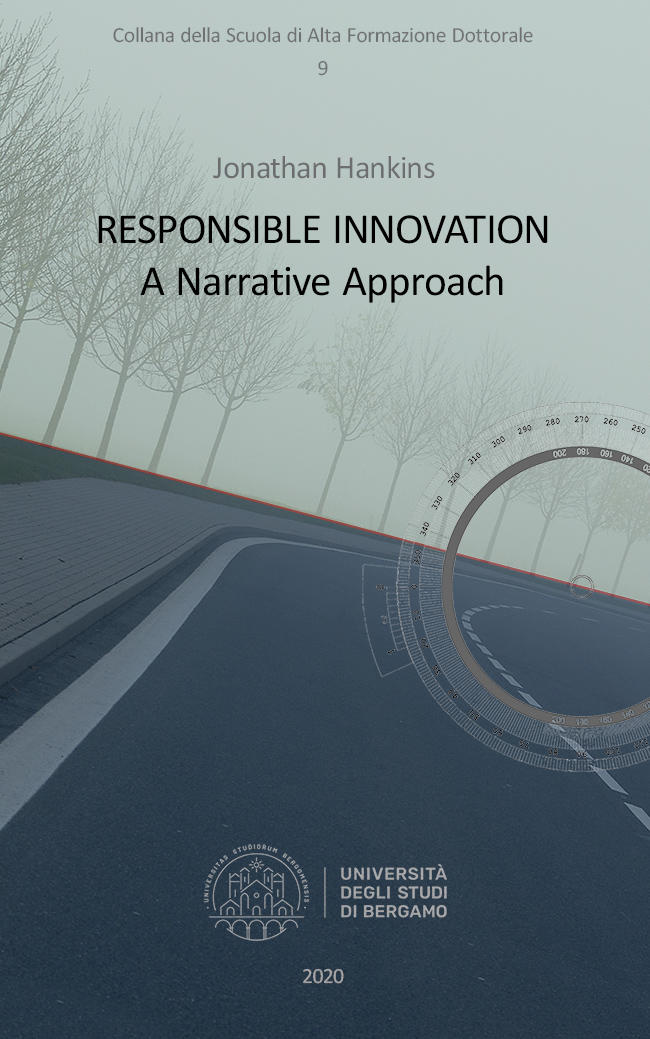The latest Responsible Innovation publication, Responsible Innovation, a Narrative Approach by Bassetti Foundation Foreign Correspondent Jonathan Hankins has just been published through the Doctorate School of Bergamo University.
The book is based on Hankins’ PhD thesis of the same name, in which he investigates one of the Bassetti Foundation approaches to thinking about responsibility in the workplace, ‘poiesis-intensive innovation’.
The book uses case studies to highlight how those following a craft approach (in a workshop or science laboratory) narrate their aims, purposes and practices. Poiesis is seen as the poetry of this narration, a construction of the elements that go into the process that are non-technical, but values, objectives or beliefs.
After an overview of the historical development of the concept of RI, analysis of the various well (and less well) known definitions in current use, Hankins puts their development into context, describing their purposes within the fields that they were developed within, before offering an overview of the current (2020) situation within the field.
The author then analyses what he describes as the scholarly narrative, guiding the reader through developments in real time, from the academic publications that now form the groundwork of thinking, through an overview of the array of different approaches (including fieldwork examples, offering a context for this book) and the influence of design.
In its own dedicated chapter, Hankins offers an overview of how the EU uses the concept, describing the largest funded projects to date before introducing a format that runs through the rest of the book, an interview that offers personal insight from a protagonist standpoint.
In this case the protagonist is one that many readers will know, René von Schomberg.
This ‘narrative’ based format with interview continues as the author presents a historical developmental perspective through the work of the Bassetti Foundation, with insight from an interview with President Piero Bassetti himself. The Foundation’s own concept of Poiesis-intensive innovation is then further developed, in a chapter that forms some of the building blocks for the case studies that follow, bringing the reader back to the guiding narrative that the book intends to develop, the goals that working practices and processes aim for.
In the first and largest of the two case studies, the concept of working towards beauty as a goal is described from the perspective of a furniture restorer in Manchester. In the second a scientist in Utrecht describes his vision in a narration that in many ways, mirrors that from the furniture workshop. The concept of skilled visions is used throughout these studies, with the focus on shared appreciation of what the process brings.
What the furniture restorer describes as beauty, the scientist sees as precision. Both descriptions are grounded in data drawn from interviews. Concluding remarks offer summaries of each individual chapter.
The book is open access and available on free download from the University of Bergamo, as well as in paperback and Kindle through Amazon. It is plainly written, and individual chapters are stand-alone, so can be read in any order.
Table of Contents
Introduction: A Narrative Approach to Responsible Innovation.
Chapter 1 Responsible Innovation, an Overview
1.1 Definitions of a Concept under Development
1.2 Overview of Definition Backgrounds
1.3 Responsible Innovation Today; an overview of the situation
1.4 Some Conclusions
Chapter 2 The Scholarly Narrative
2.1 The Groundwork
2.2 The Debate Around the Frontier Sciences
2.3 A Multidisciplinary Investigation
2.4 Further Fieldwork Within RI
2.5 International Handbook on Responsible Innovation
2.6 The Influence of Design
2.7 Some Conclusions
Chapter 3 The European Narrative
3.1 Projects Funded Under the FP7 Framework Programme (2007-2013)
3.2 Some Conclusions
3.3 René von Schomberg
3.4 René von Schomberg: An insider perspective
3.5 Some Conclusions
Chapter 4 The Italian Narrative: The Bassetti Foundation in Milan
4.1 An Overview of the Bassetti Foundation
4.2 President Bassetti in his own Words
4.3 Some Conclusions
Chapter 5 Poiesis-Intensive Innovation
5.1 Situated Learning
5.2 Skilled Visions
5.3 RI Definition and Poiesis Intensive Responsible Innovation (PIRI)
5.4 Some Conclusions
Chapter 6 Apprenticeship: Learning to See, Learning to Do: The Upholsterer’s narrative
6.1 Methodology for the Recorded Conversations
6.2 An Analysis of Recorded Conversations: Conversations with the Village Upholsterer.
6.3 Concluding Remarks: The death of our mentor
Chapter 7 The Scientist’s Narrative
7.1 Jos Malda
7.2 The Laboratory
7.3 Skilled vision: The Development of the Process on Display
7.4 Similarities in Problem Solving Techniques
7.5 Professor Jos Malda in his Own Words
7.6 Some Conclusions
Chapter 8 Concluding Remarks
8.1 Chapter 1, Responsible Innovation: An Overview
8.2 Chapter 2, The Scholarly Narrative
8.3 Chapter 3, The European Narrative
8.4 Chapter 4, The Italian Narrative: The Bassetti Foundation in Milan
8.5 Chapter 5, Poiesis Intensive Innovation
8.6 Chapter 6, Apprenticeship, Learning to See, Learning to Do: The Upholsterer’s Narrative
8.7 Chapter 7, the Scientist’s Narrative
BIBLIOGRAPHY

————-

















